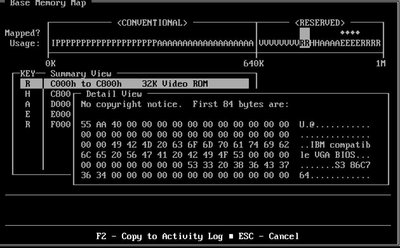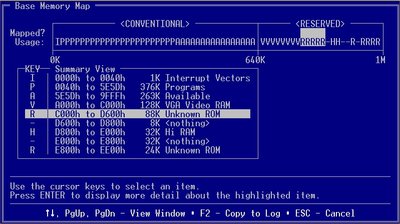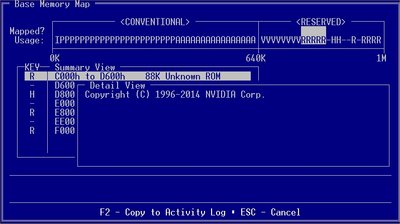First post, by ruthan
- Rank
- Oldbie
Hello,
in my pure Dos project i often face Dos not enough conventional memory problem.. this could be caused also by big videocard roms.
So i want to make some list of card names and video bios sizes.. I tried to search for it, here but i didnt find such thread.
How to discover VBIOS size:
a) Just run VBSIZE utility from FalcoSoft, it reports size in KB
b) Use Navratil software (NSSI), its more stable in Realmode and without sound drivers - Details -> Video -> Video Details - there is Video Bios size item, on first Detail->Video you could often find cards manufacturer / vendor.
c) Run these commands: // Thanks to kjliew
d) In past we recommendaed to Use CheckIT program - SystemInfo->Memory Map -> find Videp rom and read the size, you can press Enter on to check Videocard ROM vendor info.. but FalcoSoft found that sometimes is report size wrong too big..
e) C:\>debug
-dc000:0
It outputs something like this: C000:0000 55 AA 4C .. .. .. ..
User hex number after 55 AA, in this example 4C, use Windows calculator in programmers mode input number in HEX and look at value in DEC (at least Win10 calculater is showing it automatically) and after that multiply DEC value with 512 to get results in bytes. For out example 4C(hex) is 76 in DEC * 512 = 38 912 bytes, for kilobytes divite results by 1024 like this 38 912/1024= 38 KB.
List:
- ATI Mach 64 1 MB OEM - 32KB - Navratil
- Nvida Geforce 6600 GT AGP - Gigabyte GV-N66T128VP- 60 KB - Navratil
- Nvidia Geforce 6200 AGP - vendor ?? - 59 KB VBsize / Navratil
- 3DFX Vooodoo 3 2000 OEM (Elpida) PCI -bough as bulk - 32KB - VBsize / Navratil SI (NSSI)
- Nvidia Geforce 220 PCI-E - 56 KB - VBsize / Navratil is showing not primary Videocard info
- ATI X800 XL - Gigabyte GV-RX801256V - 64KB Navratil
- ATI X600 128MB -unknown vendor - 52 KB - Navratil
- S3 Virge - 32 KB - Navratil
- Matrox 1064SG (4MB Mystic) - 32 KB - Navratil
- Intel HD 4000 in CPU - 63 KB - VBSize. Navratil is not working for iGPUs
- MSI Geforce 1030 passively cooled MSI (MS-8C98) - 56 KB - Navratil
- MSI Geforce 7900 GT Microstar - MS-663- 56 KB - Navratil
- Gigabyte Geforce GTX 960: 58 KB reported by FalcoSoft, VBsize
- Inno3D Geforce 6600: 60 KB reported by FalcoSoft, VBsize
- Inno3D Geforce 7600 GT: 55 KB reported by FalcoSoft, VBsize
- Integrated ATI Radeon Xpress 1150: 64 KB reported by FalcoSoft, VBsize
- Inno3D TNT2 M64 PCI: 44Kb reported by NSSI
- Radeon X800 PCI-E 256 MB V/D/VO (i think that it is Sapphire) - 57 KB reported by VBsize
- Cardex Tseng ET4000AX ISA: 32Kb reported by NSSI
- S3 Vision 864 PCI: 32Kb reported by NSSI
- Tseng labs ET3000AX ISA - 24 KB - smallest so far, NSSI / VBsize
- Radeon HD 3450 PCI-E Sapphire - 62 KB Navratil
- Radeon X600 Pro Xpression - 64 KB Navratil
- Geforce 4 MX AGP Microstar - 59 KB Navratil
- Geforce 7600 GT PCI-E Microstar MS-8951 - 59 Navratil/ VBsize
- InnoVision TNT2 M64 AGP -64 KB reported by NSI
- Geforce 730 GDDR3 55KB - reported by Navratil
- Radeon X1300 PCI-E 60 KB - reported by Navratil
- Geforce 6600 PCIE- 60 KB Gigabyte - reported by Navratil
- Radeon X300 PCI-E 52 KB - reported by Navratil
- Geforce 8400 GS PCI-E Gigabyte 56KB - reported by Navratil
- Radeon X800 PCI-E, Gigabyte one - 64 KB, Navratil
- Geforce 730 GDDR5 58KB - reported VBSize
- Radeon X600 PCI-E OEM with DMS-59 only (my guess is that is DELL / HP) - 44 KB only reported by NSSI
- Radeon X1300 Pro PCI-E Gigabyte - 64 KB reported by Navratil
- Geforce 7950 GT MS-663 - 56 KB Navratil
- Geforce 970 MSI MS-3160 - 58 KB Navratil
- Nvidia Geforce 7800GS AGP: 58KB reported by VBsize reported by Baoran
- Tseng ET4000/W32P VLB: 32Kb reported by VBsize reported by Baoran
- ATI Radeon ( First ever radeon model from year 2000 before they used any numbers) 64MB DDR AGP: 44Kb reported by VBsize, reported by Baoran
--- Cards bellow are reported by Elianda--- if you interested about all copyrights info check its original post, i had to do some cutting - AccelGraphics Eclipse with CL-GD5436/46 PCI VGA BIOS Version 1.25 32 kB
- Alliance ProMotion AT3D PhoenixVIEW/DT(TM) VGA-Compatible BIOS Version Ref, ( Version are internal value, shown only when code is run) -32 kB
- ATI VGA Improved Performace (ViP) 761295520 21SCM 1987/12/11 12:28 ATI VIP Bios, Version 1.03 - 32 kB
- TSENG ET3000 Copyright(c)1988 Tseng Laboratories, Inc. 07/24/89 V8.00X -24 kB
- TSENG ET3000 Copyright(c)1988 Tseng Laboratories, Inc. 08/10/90 V8.01X -24 kB
- Genoa SUPEREGA HIRES+ (C) copyright GENOA Systems Corp.05/19/87Version 3.10 CDS EXTMOD -16 kB
- ATI Mach64 CT 761295520 3? 0 î 1995/09/26 10:20 ATI264-CT PCI BIOS P/N 113-32102-105 , 1988-95,BK3.7.0/2.004MACH64CTPCIU - 32 kB
- ATI Mach64 GX 761295520 31 î 1994/11/11 15:23 ATI MACH64, PCI BIOS P/N 113-25406-102 ,1988-94, .BK3.4/0.026MACH64GXPCIUN -32 kB
- ATI Mach64 VT2 761295520 3? @ ú 1996/09/27 12:06 ATI-264VT PCI BIOS P/N 113-34004-104 ,1988-96. BK3.8.0/3.008 vtppd.ati 5 MACH64VTPCIU -32 kB
- Oak OTI32C Copyright 1989, OTI VGA BIOS ECv2.13-35%Wed Jan 03 08:42:10 1990 - 32 kB
- DSystems Papilio G1-2 12/20/94 Papilio G1 - 2 Version 1.46 WEITEK P9100, PhoenixVIEW(TM)VGA-Compatible BIOS, 1991-1994 WEITEK Corp. - 32 kB
- DSystems Papilio G1-4 12/20/94 Papilio G1 - 4 Version 1.46 WEITEK P9100, 1984-1991 Phoenix Technologies Ltd. , 1991-1994 WEITEK Corp. -32 kB
- ATI Rage II 761295520 1996/12/04 15:49 ATI MACH64 GTB BIOS P/N 113-38204-102, (C) 1988-96, /3.033 -32 kB
- ATI Rage II+DVD 761295520 1997/08/29 10:08 ATI MACH64 BIOS P/N 113-38806-100 ,(C) 1988-97,/3.048 gthc1k.a1 6 MACH64GUPCIMTHPU - 32 kB
- ATI Rage Pro Turbo (SGRAM version) 761295520 1998/10/27 17:29 ATI MACH64 BIOS, (C) 1988-97, BK3.9.3/3.089 gtgpmc.c 6 - 32 kB
- ATI Rage XL 761295520 2000/01/20 10:26 ATI MACH64 SDRAM BIOS P/N GM-xls3p.hu-4.326, (C) 1988-1999, BK4.3.02/4.326 - 38 kB
- Number Nine Revolution IV -1998 -Version 3.06.00 , PCI AGP -66 RAM -8 -16 on 08/21/98 Number Nine Visual Technology Revolution IV T2R4 BIOS -32 kB
- ATI Rage 128 GL 761295520 1999/03/24 17:31 RAGE128 GL AGP P/N 113-61303-100,(C) 1988-98, BK1.0.12 VR001.001.001.012- 44 kB
- ATI Rage Pro Turbo AGP SGRAM 761295520 1998/06/03 11:16 ATI MACH64 BIOS P/N 113-40214-102 , (C) 1988-97, BK3.9.2/3.086 -32 kB
- SIS 6326 BIOS Ver 1.26 02/02/1999-09:35:03 SiS 6326 AGP True Color Graphics+Video Accelerator SiS 6326 PCI - 6 MB VRAM, BIOS Version 1.26 -32 kB
- Trident 8800CS 07/05/89 D4-129 000ë= MODE, 1988, 1989 TRIDENT MICROSYSTEMS INC. U3, 32 kB
- SPEA/V7 Vega Video Seven BIOS Code, Version 1.12 (C) Copyright 1987 Video Seven Inc., Updated: 03/26/88 ,BIOS Code- Version 1.12 - 32 kB
- SPEA/V7 Vega Video V7-VEGA VIDEO Bios Version 5.10 Copyright 1995, SPEA / VideoSeven,91-95, Avance & Quadtel Corp., 10/13/9009/13/95 -32 kB
- SPEA/V2 VEGA VGA Video Seven BIOS Code, Version 1.78 (C) 1987, Updated: 05/09/89 Video Seven BIOS Code, Version 1.78, 32 kB
- ATI VGA Wonder XL 761295520 1991/9/24 11:54 ATI VGAWONDER XL, BIOS P/N 11201122030, (C) 1988-91, ATI Technologies Inc., 32 kB
- S3 Virge GX ACER OPEN PT75 Video BIOS. Version 2.01.13B Copyright 1996 S3 Incorporated. 08/12/9709/15/97- 32 kB
- S3 Incorporated. ViRGE /DX /GX S3 Incorporated. ViRGE /DX /GX Rev B -32 kB
- S3 Virge VX miroCRYSTAL VR 4000 PCI Rev.2.00 10/01/96 -32 kB
----end of Elianda stuff--- - Radeon 3450 AGP 512M DDR2 Sapphire - 62 KB - reported by VBsize
- Geforce 6100 onboard - OEM ECS MB - 59 KB - Navratil
- Trident PCI 9440 1 MB - 32 KB - Navratil
- Radeon 4850 Asus - 64 KB - VBsize
- Geforce 6200 Turbocache - MSI - 59 KB VBsize
- Geforce 5600 AGP - 62 VBsize
- ATI 4770 512MB PCI-E (RV740) VTX (Visiontek) (Walden B74302 Board) VBE 3.0 by FalcoSoft / NSSI 63k reported by AvalonH
Disruptor : Please remember that for UMB usage with EMM386 there is a 4 KB alignment, so 54/55 KB means 56 KB, 57/58/59+ Kb->60KB is reality etc.
Pleas report your cards and its Bios ROM sizes,vendor and exact name could matters too.
Todo /Question?:
1) Its possible to check DOS VBIOS size / Vendor / Cardname, in Windows and Linux? If yes how? I know that you can make dump, but its i hope there is cleaner way..
Elianda: Some video cards drivers replace the BIOS you have in Windows. So if you dump from Windows you get a different image. e.g. the driver for the DSystems Papilio G1-x cards does it. In Windows you have a BIOS that is fully VBE3.0 capable.
3) Its possible to show more Video card info in pure DOS, its somewhere in ROM? / PCI registers, i tried HWinfo etc.. but information are usually useless / wrong etc.. I interesting, in VRAM size, memory / clock speed, card chip, brand etc? => Navratil is able to do it for some cards, far some ideal, but its nice too.
There ismy Dos videocards performance thread, if care about it.
Too keep thread with reasonable # of posts, i would be nice: Post report - I will added card to my link creditcs include and delete report post, if is not contain other important info..
Im old goal oriented goatman, i care about facts and freedom, not about egos+prejudices. Hoarding=sickness. If you want respect, gain it by your behavior. I hate stupid SW limits, SW=virtual world, everything should be possible if you have enough raw HW.


